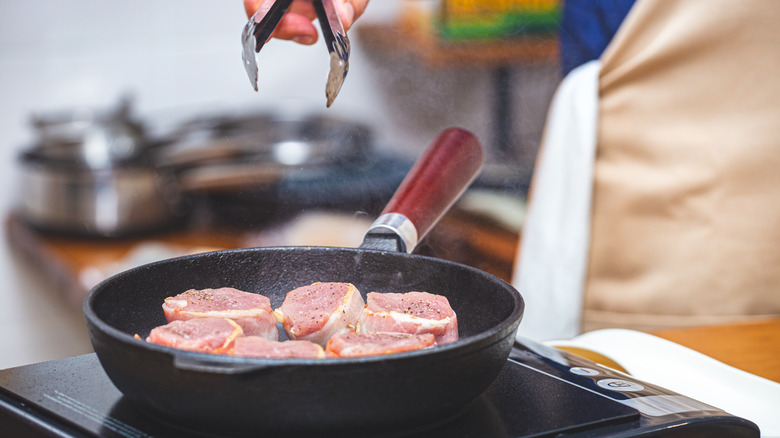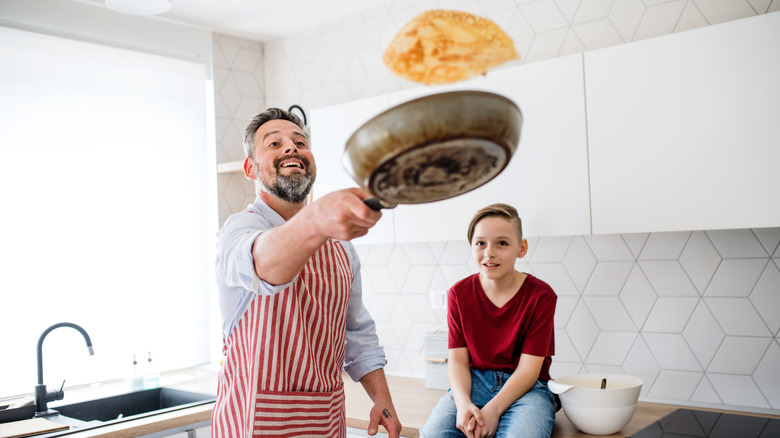A Perfectly Executed Skillet Toss Is Good For More Than Just Showing Off
Midway through the first episode of your latest Netflix indulgence, the camera trains on a new character. They're standing in their kitchen, in front of the stove, making something — doesn't matter what, really. Could be as basic as a fried egg or as rarified as fatted goose liver – because what really matters isn't so much what's in the skillet as the deftness with which this character to whom you're now being introduced by skilled storytellers shows themself to be capable of handling said skillet.
If their next move is to stir lackadaisically, you wouldn't be wrong for concluding this character probably isn't particularly passionate about cooking. By contrast, if they don a clean oven mitt, grab the skillet firmly by the handle, and with a seeming flip of the wrist, send its contents floating up into a gentle arc that terminates exactly where it began (only flipped over so the other side of whatever it is can now cook), then you've likely got a foodie on your hands. Moreover, if they manage a perfectly executed skillet flip with one hand while casually grabbing their insistently ringing phone with the other, then this character may, indeed, turn out to be a chef.
Whether you call it a skillet toss, a pan flip, a sauté snap, or something else entirely, it's not just about showing off. It is an actual signifier — in real life as well as on screen — of prodigious cooking skills. Because skillet tossing matters.
Skillet tossing can level up your cooking game
While you can be a great cook even if flipping your tenderloins means taking out the tong, it seems like well-honed skillet tossing skills might comprise an unwritten prerequisite for anyone wishing to be taken seriously as a chef. That said, a perfectly executed skillet isn't just for show. It can actually help launch one's cooking to next level greatness.
Skillet tossing comes in handy in myriad ways. To wit, it frees up a hand — not just to answer your phone, but also to adjust the burner or turn on the fan. It eliminates the need for locating and dirtying a spatula. And, of course, it's faster than turning your food over, piece by piece, with a pair of tongs or a fork. And all of that can definitely make your cooking experience feel smoother and more seamless. But having the ability to flip all your food in one fell swoop also stands to make an actual difference in your end result.
First, when you first introduce your food to a hot pan, the food will cool the pan down; flipping the food gives the pan a chance to gain back some of that lost heat, per UCC Culinary Arts. Further, tossing the contents of your skillet means that all pieces get equal exposure to the pan's heat — which can't happen, for example, if you're searing scallops and turning over each scallop individually.
Read on for expert tips on perfect pan tossing.
Tips for would-be tossers
As much as the skillet toss might look like an up-and-down motion — and, obviously, there is some degree of up-down happening, it's much more about lateral movement, as DVO explains. So, with an underhand grip, rather than hoisting the pan upward using your elbow, you're going to want to quickly push the pan forward — from your shoulder, but at a slight downward angle, maybe 40 degrees, per Stella Culinary.
This motion will gently launch the food in the pan upward. And, since, presumably, you're using a pan with curved sides, the laws of physics dictate the food is going to arc back down toward the pan. Using your shoulder once again, snap that pan back upwards and towards you. Et voila!
It's easier than it looks, and worth it if you want to take your cooking to the next level. If you'd rather keep the stakes manageable as you learn, then consider a literal dry run (or two or 10,000, as aspiring experts may choose to do). You can use marshmallows — try a variety of sizes to get a feel for flipping different sized bits of food. Or you can use any of these breakfast cereals, ableit bearing in mind that the skillet toss will be more challenging with Rice Krispies than with, say, Honeycombs.
Oh, one more thing: The first few times you try skillet flipping for real, don't start flipping until you're certain the food's not stuck to the skillet's bottom.


